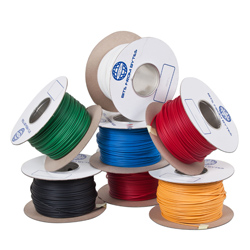3D Printing Materials are not Limited to Plastic…
This time, I will try to teach you something about 3d printing materials. When you have bought a 3d-printer, you will have to fill it with a sort of ink, like in your normal printer, but what do you fill it with? Here’s an overview of the most used filaments in the 3d-printing industry:
Thermoplastics
When it comes to 3d printing materials, ABS and PLA plastics are used most on consumer-oriented 3d printers, using a technique called ‘extrusion’. However, these printers are not limited to polymeres, some can even print with food. Imagine one day your hamburger being printed by a machine in your kitchen, or your gun printed in 3d in your garage…

Another technique through which plastics are used is with a granular 3d printer. This printer is fed with granes of plastic, metal, titanium or ceramic alloys. With increased demand, the price for plastics is going up. Recycling is key, don’t throw away the scraps; or is it really just as expensive?
Metal alloys
Also, you’re not limited to plastic, their are also metal 3d printing materials available. With wire-fed 3d printers, one can use almost any kind of metal alloy. This process is called Electron Beam Freeform Fabrication. Factors like temperature, price, should be taken into consideration when buying a metal filament 3d printer, for they are not cheap.
Bioprinting
Pick the odd one out. Yup, it’s already possible to use living cell tissue as 3D printing material. Applications range from printed ears, noses, skin tissue and other organs. In December 2013 The Netherlands got its first skin-printing device, to be used in the burn ward. The usage of 3D printing in the medical sector will offer huge opportunities, giving better recovery prognoses for a wide range of diseases, conditions or accident.
How its made:
http://youtu.be/20R9nItDmPY
What 3d printing materials do you prefer?





Can NinjaFlex filament be used in a Printrbot Simple Metal? Anyone ever try it?